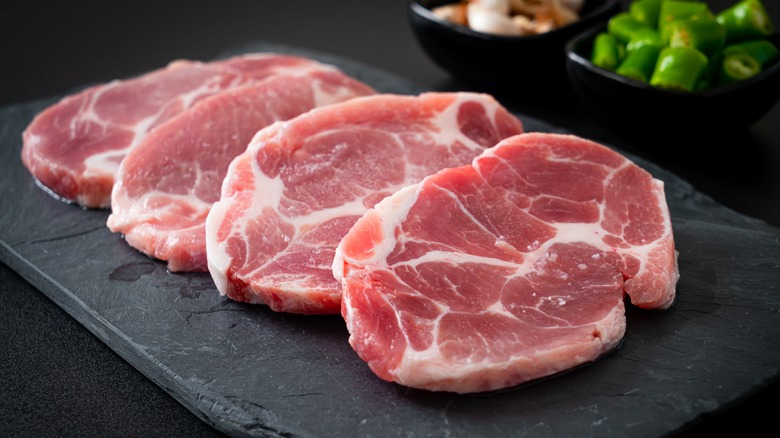The USDA Pork Grading Rules You Should Be Aware Of
Choosing the right cut of meat in the grocery store can be a challenge for everyone, and while grading can help, the USDA's pork grading rules aren't as straightforward as others. The best-known USDA grading system is for beef because it's often prominently displayed on labels. Beef can be either prime, choice, select, standard, or commercial grade. All are perfectly safe to eat; the grading system simply measures the cut's quality based on objective standards like fat marbling and subjective qualities like tenderness, flavor, and juiciness. Prime and choice are the two best, and you've likely seen local supermarkets flaunting the grade when they're selling it.
The grading rules for pork and chicken are more opaque to consumers because sellers don't usually advertise them. Chicken is also graded for quality, but usually, only the top grade is sold in stores, with lower grades used for processed chicken products, so there is no need to distinguish the grade on the package. Pork is where things get a little more complicated because there are definite variations in fat marbling and tenderness with cuts like pork chops, but it doesn't seem to get as much scrutiny as beef. So how does the USDA grade pork?
The USDA only has two grades for pork
While the USDA classifies pork as red meat, its grading system is closer to chicken. The two grades pork can receive for quality are "acceptable" and "utility." Like Grade A chicken, only pork that's graded acceptable is sold in stores, while the utility grade is used in other processed products like pet food. Though subject to all the standard safety inspections, pork's grade quality comes down to little more than the proportion of lean meat to fat and bone. There is a second system for how pork is classified, tied to the size of the pig and whether it is male or female, though this still only speaks to the ratio of fat to meat and isn't all that relevant to consumers.
So how do you know if your cut of pork is high quality? Well, thankfully, there are a few labels that can give you hints. Pork that the USDA has labeled organic or free of additives like antibiotics will have likely been raised in better conditions and be of higher quality. You can also take a look at your pork and make a few judgment calls. Like beef, more marbling means more flavor and a juicier cut. Good pork also tends to be a deeper pink color, so avoid cuts that look too pale. The USDA may not be giving you too much advice with pork, but a little scrutiny on your part can easily make up for that.

